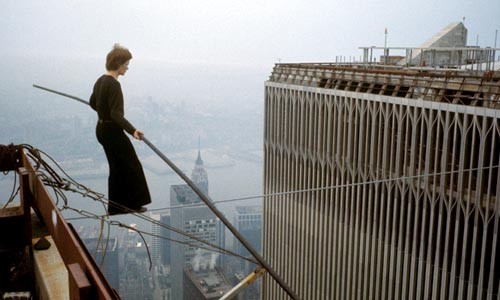On Aug. 7, 1974, a young Frenchman named Phillippe Petit, in a totally unauthorized performance, walked for nearly an hour on a tightrope wire strung between the tops of the World Trade Center's twin towers. Without a net.
If you can even bear to consider this unthinkably dangerous act, then make haste for James Marsh's fascinating documentary Man on Wire. More than just a straightforward account of the event, Marsh's work also probes the quixotic project's origins that combined art, subterfuge and public spectacle.
Now nearly 60, the still-puckish Petit is an enthusiastic and articulate narrator. The self-taught wire-walker was only 17 when an artist's rendering of the yet-to-be-built World Trade Center sparked a mad desire to span the towers on a wire. "The object of my dream," he recalls, "doesn't exist yet."
More poet than braying showman (think Evel Kneivel), Petit appeared drawn to the sublime visual symmetry of the towers rather than to any daredevilish aspect afforded by their remarkable height (then, the tallest buildings in the world). His former colleague Jean-Louis Blondeau concurs: "That's why they built [the towers] ... for Phillippe to walk between."
Previously, Petit and his revolving crew of cohorts had "conquered [other] beautiful stages," including unauthorized high-wire-walking acts above Paris' Notre Dame Cathedral and the Sydney Harbor Bridge, in Australia.
Marsh recounts the event -- nicknamed "The Coup" by Petit -- in a linear fashion, taking us through the months of preparation, supplementing contemporary interviews with dramatic recreations filmed in black and white. Marsh also draws on a remarkable amount of archival footage of Petit. Among his crew of colleagues, co-conspirators and stray accomplices were those who documented (with still and moving cameras) much of the planning and execution of Petit's capers.
As fascinating as the walk is how it all transpired: This was an illegal act that involved surveillance and reconnaissance, disguises, trespass, and, during one fraught night, the rigging of a wire (plus guy lines) across the 200-foot gap between the two towers. It's the stuff of a heist drama (as well as, in places, a complicated physics problem).
Given Petit's fanciful affection for and obsession with the Twin Towers, and the surfeit of archival footage of the building, Man on Wire can't help but also play as an elegy for the WTC. (And to my eyes, at least, lend the buildings a certain insouciant charm that the twin monoliths never seemed to convey.) The events of Sept. 11 are never mentioned, but the ultimate fate of the towers hangs moodily over the film. Part of what drew Petit to the towers was their immutable solidness, and yet, how quickly they vanished, as if their permanence had really been an illusion all along.
While 9/11 is inextricably intertwined with politics, Petit's gambol at the WTC was conceived and executed strictly as an act of art, a spectacle of public beauty, with no political overtones, even during those tumultuous and angry times. (President Nixon resigned two days later.)
And what a spectacle! Footage and photographs of Petit walking, turning, dancing and lying down on the wire between the towers may make the acrophobic tremble vicariously, but there's no denying the almost otherworldly beauty of the act.
Not surprisingly, Petit was eventually forced to step into the sheltering handcuffs of New York's finest, one of whom in a later television interview couldn't disguise the thrill he felt witnessing this "crime." Similarly, on the standard police complaint form under "Details of Complaint," some policeman, with the economy of a poet, simply typed: "MAN ON WIRE." In English, and French, with subtitles.

Starts Fri., Aug. 22. Manor


